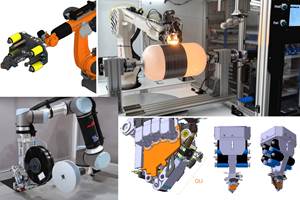MSP CNC metrology cuts Leonardo tiltrotor blade production time from 20 weeks to 3 days
Advanced manufacturing metrology demonstrates its prowess in addressing complex composite machining issues, increasing Leonardo’s carbon fiber part productivity by more than 4,500%, and eliminating scrap and fixture reliance.
MSP PerfectPart cut the production time of Leonardo’s tiltrotor blades from 20 weeks to 3 days. Source (All Images) | MSP
Global industrial group (Rome, Italy) has experienced a leap in its production of complex carbon fiber tiltrotor blades for one of its helicopter programs after implementation of advanced CNC metrology solutions from (MSP, Northumberland, U.K.) cut production time from 20 weeks to 3 days, an increase in productivity of more than 4,500%.
Leonardo has also seen its part alignment process reduced from days to 5 minutes, estimated scrap rate reduced from 95% to 0% and reliance on using fixtures for part alignment processes eliminated.
Faced with the challenge of producing large, twisted composite blades that were deemed “impossible to manufacture” by simulation software due to varying levels of distortion and a thin tip making them hard to fixture, Leonardo turned to MSP’s PerfectPart suite of metrology products.
“To align our parts, we would normally probe and measure parts using CAD, but as the composite blades are often all different and never conform to this data, we had to find another way,” explains David Madigan, Leonardo tooling design engineer.
Originally, Leonardo considered tackling the problem itself using traditional manufacturing methods, but this was predicted to create a 18-20 week lead time and was therefore deemed an unsuitable option. A feasible solution was metrology-package MSP PerfectPart. According to MSP, its NC-Checker and NC-PartLocator product modules give manufacturers error-free and right-first-time part production.
NC-Checker was introduced as a standard operating procedure at Leonardo for its ability to assess the geometric performance of a CNC machine tool to check that it is capable of machining parts to tolerance. “The tiltrotor blades are low volume and high value, so you don’t want to risk scrapping any,” says Madigan. “NC-Checker allows us to monitor the machine tool in a simple way and gives us the confidence that no error on the machine will negatively impact the parts. Before we machine a blade, it is a stipulation that the software is run. Then, if something does go wrong, the first question is ‘Well, did you run NC-Checker?’”
NC-PartLocator was introduced to solve Leonardo’s main challenge of accurately aligning the blades despite the unknown amounts of distortion. Unlike traditional part alignment methods, NC-PartLocator uses five-axis probing to measure a part on the machine and generate an accurate best fit alignment in six degrees of freedom.
MSP’s James Dent (left) pictured with Leonardo tooling design engineer David Madigan (right) and CAD CAM engineer Keith Upton-Pittaway (middle).
Most importantly in Leonardo’s case, the software compensates for any discrepancy between the physical part location and the nominal machining program to show where the part “really is” on the machine. The updated alignment is automatically uploaded to the controller and any misalignment errors are automatically removed.
Madigan admits the product shocked him. “NC-PartLocator’s alignment results can be quite surprising. The software often shows that the blade should be somewhere else entirely, even when it doesn’t look any different on the surface.” It has also aided his fixturing routine. “I designed the fixtures based on the fact that you move the machine to the part instead of moving the part. All I needed to do was hold the part in position so it could be probed. It didn’t matter that the blades were all variable and the position wasn’t correct, as I knew NC-PartLocator would compensate for that. It’s night and day compared to traditional methods.”
And the results certainly show this difference. Using MSP as part of its processes, Leonardo has cut its estimated 20-week production time and 95% scrap rate to a stable 3-day production time with a potential for 0% scrap rate.
Related Content
Industrializing additive manufacturing in the defense/aerospace sector
GA-ASI demonstrates a path forward for the use of additive technologies for composite tooling, flight-qualified parts.
Read MorePlant tour: Aernnova Composites, Toledo and Illescas, Spain
RTM and ATL/AFP high-rate production sites feature this composites and engineering leader’s continued push for excellence and innovation for future airframes.
Read MoreBladder-assisted compression molding derivative produces complex, autoclave-quality automotive parts
HP Composites’ AirPower technology enables high-rate CFRP roof production with 50% energy savings for the Maserati MC20.
Read MoreThe next evolution in AFP
Automated fiber placement develops into more compact, flexible, modular and digitized systems with multi-material and process capabilities.
Read MoreRead Next
AIMM Center for advanced composites NDT opens in Ogden, Utah
Attendees from SpaceX, Northrop Grumman, Hill AFB, 47G and others joined CICNDT and Omni NDE to demonstrate the latest in robotic CT, RT, shearography, thermography, laser UT and metrology.
Read MoreOtto Aviation launches Phantom 3500 business jet with all-composite airframe from Leonardo
Promising 60% less fuel burn and 90% less emissions using SAF, the super-laminar flow design with windowless fuselage will be built using RTM in Florida facility with certification slated for 2030.
Read MoreNext-gen fan blades: Hybrid twin RTM, printed sensors, laser shock disassembly
MORPHO project demonstrates blade with 20% faster RTM cure cycle, uses AI-based monitoring for improved maintenance/life cycle management and proves laser shock disassembly for recycling.
Read More












